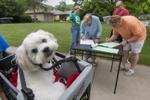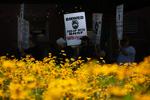‘Emotional journey’: Crete teacher travels to Wyoming to learn about dark corner of American history | Education
[ad_1]
Family road trips from Lincoln to the sleepy Wyoming towns of Ten Sleep and Worland were fixtures of Nikki Menard’s summers growing up. Her adoptive parents hailed from the two towns in the Bighorn Basin, a sprawling arid plateau flanked by mountains and cut by rivers.
But despite how familiar she was with the region, it wasn’t until Menard was older that she learned the story of Heart Mountain, one of 10 prison camps in the U.S. where Japanese Americans were relocated during World War II.

Nikki Menard
It’s a dark corner of American history that Menard is working to make sure is never forgotten — or repeated.
The Crete High School English and journalism teacher was one of 72 educators from across the U.S. invited to a workshop at the Heart Mountain National Historic Landmark site to learn more about the camp’s history — and to create their own lesson plans on the history of Japanese American incarceration.
“It was an extremely emotional journey,” she said.
Menard was among 270 teachers who applied for the National Endowment for the Humanities fellowship to attend one of two workshops.
Teachers received a $1,300 stipend to cover lodging and travel to the Heart Mountain site, which is near Cody, Wyoming, in the Bighorn Basin.
LPS superintendent: Targeted masking approach appears to be ‘new normal’
Watch now: LPS officials tout the high school of the future on tour of Lincoln Northwest
More than 14,000 Japanese Americans, the large majority of them U.S. citizens, were relocated from the West Coast to the internment camp following Japan’s 1941 attack on Pearl Harbor.
At its peak, the site was the third-largest city in Wyoming and featured a hospital, mess hall, schools and other facilities.
Barbed-wire fences and guard towers surrounded hundreds of tar-paper barracks, where families were housed in tiny apartments with no indoor plumbing and poor insulation.
“It was a pretty wretched place to live by any objective standard,” said Ray Locker, who oversees the workshops.
Today, the valley is radically changed, home to lush fields of barley and other crops — the result of irrigation practices the Japanese Americans introduced during their incarceration.

A guard tower at the former Heart Mountain internment camp in Wyoming, where thousands of Japanese Americans were imprisoned during WWII.
Zach Hammack
A museum keeps the memory of the site alive, now, and there is a walking trail and expansive root cellar still in place that were built by the prisoners.
Teachers spent a week on the site learning from trained faculty about the history of Japanese American incarceration, which President Franklin Roosevelt ordered in February 1942 amid growing concerns about national security.
The concerns were unfounded, but about 120,000 Japanese Americans were eventually incarcerated nonetheless.
“When you take somebody to the place where a historical event happened like this, it’s transformative,” Locker said.
Educators were also able to meet former prisoners who gathered at Heart Mountain for an annual pilgrimage. And dignitaries — including U.S. Rep. Liz Cheney of Wyoming and her former vice president father — were on hand.
For Menard, a member of the Oglala Lakota tribe, Heart Mountain contains even more meaning beyond its significance during WWII.
The land once used to imprison Japanese Americans was originally home to the Crow tribe, which was relocated by the U.S. government. The tribe also holds an annual pilgrimage to Heart Mountain — considered sacred by the Crow — which Menard was able to attend last week.
“It was a really spiritual experience,” she said.
Now, Menard plans to take what she learned back to her students in Crete through a unit she developed that deals with place, identity and culture.
“It deserves attention,” she said. “We don’t have to make those mistakes again.”
From the classroom: New pizza chain coming to Lincoln high school cafeterias
After ‘gut-wrenching’ car-pedestrian collision, city making changes to Saratoga school zone
Top Journal Star photos for July

Teri King (left) and Tom Dorshorst dance during The Zoo Bar’s ZooFest music festival July 8.

Dominic Silva (left) lifts up Dertha Williams with help as he pushes her on a tire swing during Lincoln’s annual Uncle Sam Jam at Oak Lake Park on Sunday.

Women display signs to passing cars during an abortion rights rally held in front of the Nebraska State Capitol on Monday.

Nebraska state Sen. Julie Slama hugs a campaign volunteer after a press conference hosted by Citizens for Voter ID at the Capitol on Thursday. Citizens for Voter ID submitted petitions to the secretary of state to add a voter ID requirement to the state constitution.

Skaters perform during the USA Roller Sports Roller Figure Skating Indoor National Championships on Saturday at Speedway Sports Complex.

Carpet Land’s Owen Laessig’s hat flies off his head as he throws to first base to retire a JC Brager batter on June 29, 2022, at Den Hartog Field.

Cathy Smith (from left), Rick Boucher and Shelly Horton ride horses in Pioneers Park on Monday. The city has approved restoring 1.9 miles of horse trails in the park.

Charity Reeves is shown Friday in her kitchen in Nebraska City. Reeves said her brain fog persists after recovering from the initial symptoms of COVID-19, and she has to rely on note cards to remind her of daily tasks such as turning off the stove.

Nebraska State Patrol Trooper Ravi Singh demonstrates a drone during a news conference on Thursday at Nebraska State Patrol headquarters.

Konni Anderson (left) talks with Becca Monroe of West Mill Flowers Friday.

Customers carry out fireworks from Black Dragon Fireworks in Hickman on Friday.

Ashley Peterson, a special-education teacher at Lincoln Northwest who suffers from prosopagnosia, also known as facial blindness, was recently featured in a National Geographic story talking about the condition.

Dana Davenport, Josie Kinsinger and Dee Bronson (from left) set up a phone so they can film a reel for Instagram at Aria Rose Bath Co. on Thursday.

Andie Trimble (left) and Nicole Polivka wear paint-stained dresses while protesting the recent Supreme Court decision to overturn Roe v. Wade during an abortion rights rally held in front of the Nebraska State Capitol on Monday.

LINCOLN, NEB. – 07/06/2022 – Buster the dog looks on as supporters of medical marijuana sign petitions, Wednesday, July 6, 2022. JUSTIN WAN, Journal Star

LINCOLN, NEB. – 07/10/2022 – Protesters march around Lincoln Station during a rally in support of union rail workers, Sunday, July 10, 2022. Union rail workers in Nebraska are negotiating a new contract under the Railway Labor Act, after the previous contract expired in 2019. NOAH RIFFE, Journal Star

Lincoln’s catcher Skyler Weber reacts after scoring a run against Kansas City during Saturday’s game at Haymarket Park.

Ozzie Pederson gives her Warmblood horse, named Smokey, a bath in preparation for the Lancaster County Super Fair, which starts Thursday.

Lincoln High’s Beni Ngoyi (center) and others, including Adonis Hutchinson (first from right), gather for a photo after Ngoyi announced his commitment to Iowa State on Wednesday at Lincoln High School.

Adam Helmerichs, owner of Diamond Concrete Cutting, organizes tiles removed from the Pershing Center mural Wednesday.

A young Husker fan takes a photo of Memorial Stadium during Nebraska Football Fan Day on Tuesday.

Carpet Land celebrates after defeating Pinnacle Bank in the A-5 American Legion tournament championship Tuesday at Den Hartog Field.

Union Bank’s Thomas Neal is shown during an American Legion Area 5 tournament game against Carpet Land on Sunday, July 17, at Den Hartog Field.

Racers run out of the starting line during the Husker Road Race Sunday at Memorial Stadium.

A 1962 Chevrolet Corvette Convertible is auctioned off during the Remlinger Collector Car Auction at Pinnacle Bank Arena.

Ashley Peterson (right) adjusts the mortar board cap for her son, Bryce Peterson, during a graduation ceremony from Future Husker University at Memorial stadium on Friday.

An attendee looks at tractors during the Camp Creek Threshers show Saturday near Waverly.

Former Papillion-La Vista softball player Jordy Bahl, who now plays at Oklahoma, lights the torch during the Cornhusker State Games’ Opening Ceremonies on Friday at Seacrest Field.

A dragonfly lands on a lotus, Monday at Sunken Gardens, where temperatures topped out in the low 90s.

Platte county attorney Jose Rodriguez stands outside of the Platte County Courthouse.

Sampson Construction third baseman Noah Thiele leaps over Pinnacle Bank’s Max Olivas during an A-5 district Legion game Thursday at Den Hartog Field.

Dallas McGee, who is retiring at the end of the month from the city’s Urban Development Department, poses for a photo at Bill Harris Iron Horse Park in downtown Lincoln. In the early days of the Haymarket redevelopment, renovating Lincoln Station and creating Iron Horse Park was considered a turning point for development in the area, McGee said. “All of a sudden, people were saying ‘we need to take you down and show you Iron Horse Park’” when visitors came to town.

As temperatures in Lincoln soared toward the upper 90s on Tuesday, families took advantage of the spray ground at Trago Park. Temperatures are expected to stay in the 90s for the next week and possibly top 100 on Friday and Saturday.
Contact the writer at [email protected] or 402-473-7225. On Twitter @HammackLJS
[ad_2]
Source link
